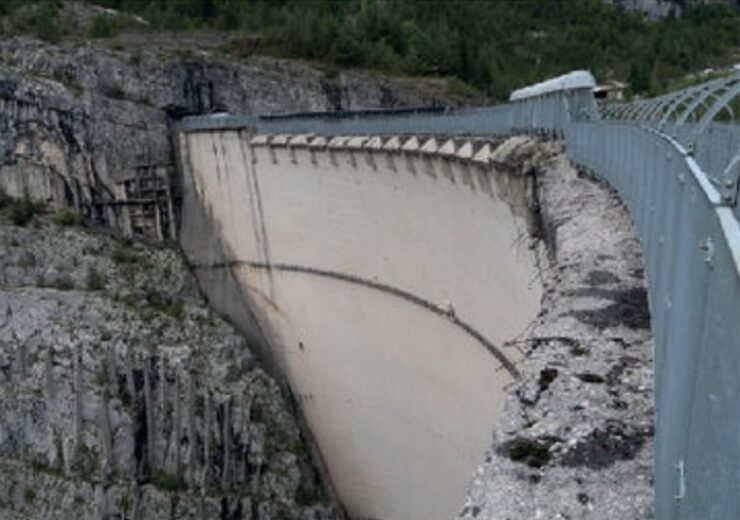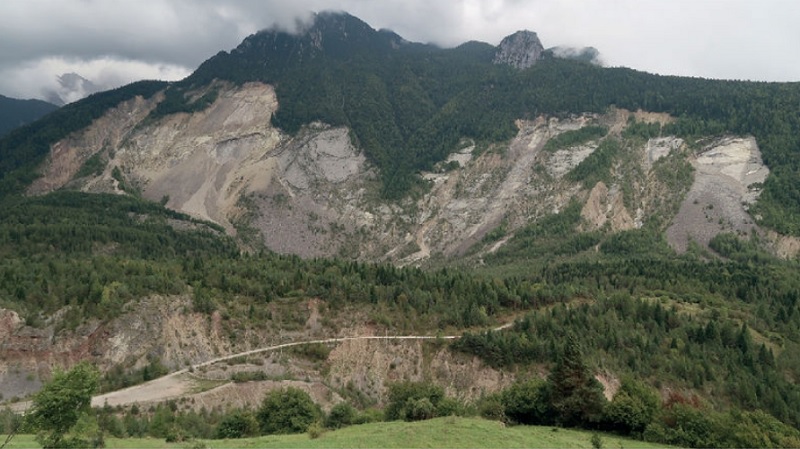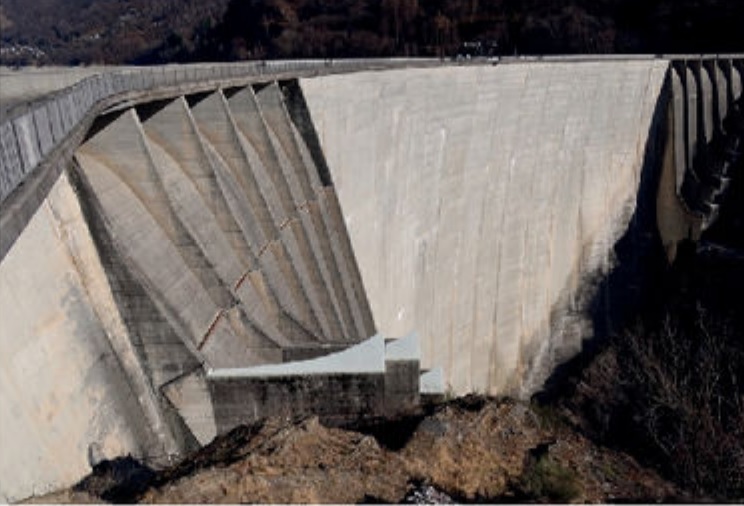Dr. Martin Wieland, Chairman of the Committee on Seismic Aspects of Dam Design, International Commission on Large Dams, reflects on the seismic safety of dams

Overtopping of the 262m high Vajont arch dam in Italy caused by rockslide into the reservoir in 1963. (Credit: Dr. Martin Wieland)
In the early 1970s, when I first got involved in the dynamic analysis and safety assessment of concrete dams and was working in the Laboratory of Hydraulics, Hydrology and Glaciology at the Swiss Federal Institute of Technology in Zurich, Switzerland, some dam engineers believed or hoped that by means of earthquake prediction or early warning it would be possible to ensure the seismic safety of dams.
Most of the Swiss dams are concrete dams, which have an average age of about 75 years and were designed against earthquakes using the pseudo-static analysis method with a horizontal seismic coefficient of 0.1, ie a method which is considered obsolete today. Thus by timely earthquake prediction, it would have been possible to lower the reservoir and the people living downstream of a dam would have been safe. However, it turned out that this was a pipe dream and is still unattainable today. Hardly any progress has been made in the last 50 years in the prediction of strong earthquakes, which includes the prediction of their magnitude, place and time. If earthquake prediction is possible and the warning time is sufficiently long, then the reservoir could be lowered before a strong earthquake occurs.
About 20 years ago, two earthquake early warning systems were installed for the Ignalina nuclear power plant in Lithuania and the city of Istanbul in Turkey. These systems included seismic sensors installed at different locations at a distance of 30km around the power plant site, on several islands in the Marmara Sea in the vicinity of Istanbul and provided theoretical warning times of less than ten seconds. This required real-time monitoring and processing of the seismic data. It is obvious that within this short period of time no actions could be taken at large storage dams except for alarming the people living downstream of a dam. Although alarms would not save the lives of people unable to escape from buildings shaken by earthquakes, they could save them from a flood wave caused by the failure of a dam, which should be standard practice today.
Therefore, the only option is to design and build dams that must be strong enough to withstand the strongest ground motion expected at a dam site, which is the current seismic safety concept of ICOLD for high-consequence failure of water storage dams.

Ambiguous
It is well known that the concept of strongest ground motion is somewhat ambiguous as there are large uncertainties involved in its estimate. Thus, it is recommended to review the seismic design and safety criteria periodically and in the case of important changes in the seismic hazard, the risk classification of dams or the seismic safety criteria, it is necessary to carry out a re-assessment of the seismic safety of dams. As well-designed, well-built and well-maintained dams have a very long lifespan such a safety assessment may be carried out repeatedly at intervals of say 20 to 40 years. Moreover, for estimating the seismic hazard both deterministic worst-case earthquake scenarios and probabilistic seismic hazard analysis methods should be used.
If both types of analysis are carried out the most unfavourable ground motion parameters should be used as the input for safety analyses. As seismic hazard analyses have become very sophisticated and much effort can be given to such analyses, it should not be forgotten that with advanced seismic hazard analyses the dam safety does not improve. Therefore, in view of the remaining large uncertainties in the seismic hazard, it is better to spend the resources in the actual design and construction of dams that are least vulnerable to seismic actions.
In addition, the ground motions used for seismic safety evaluations are not real earthquake ground motions but instead models of the ground shaking that ensure the safe design of a dam. This is an old and proven concept in the civil engineering profession, where, for example, different models of the live load on bridges are used to calculate the maximum stresses and deformations, although these models have little in common with the actual live loads on these bridges.
Until recently, it was thought that the seismic safety of dams was assured when the dam body could resist the effect of ground shaking. This is still correct but, in addition, it must be realised that during strong earthquakes, besides ground shaking, landslides or rockfalls may occur. These can block the intakes of spillways or low-level outlets that have to function after the earthquake or they may lead to impulse waves in the reservoir that could overtop the dam crest as, for example, in the case of the Vajont dam in Italy on 9 October 1963.
In addition, the possibility of movement along faults or other discontinuities in the footprint of a dam must be investigated, which, for concrete dams would have more severe effects than ground shaking. Besides the dam body, the following structures must also be safe and have to withstand the same seismic actions as the dam body:
1. Spillways and low-level outlets must function after strong earthquakes.
2. The stability of wedges in the dam abutments must be ensured, which is of main concern for arch dams.
3. The stability of slopes, whose failure may block the intakes of spillways or low-level outlets, must be checked.
4. The effects of potential landslides in the reservoir region or even in the catchment area, which may create large impulse waves or extreme floods or debris flows have to be checked.
These are safety aspects that have hardly been considered systematically up to now. These new requirements are a direct consequence of the comprehensive seismic safety concept, which includes the following:
1. Retain the reservoir and protect people from a catastrophic release of water from the reservoir.
2. Control the reservoir level after an earthquake as a dam could be overtopped and destroyed if the inflowing water into the reservoir cannot be released through damaged spillways or low-level outlets.
3. Lower the reservoir level after an earthquake (i) for repair works, (ii) for increasing the safety of a damaged dam or (iii) when there are doubts about the safety of a dam.
Thus, low-level outlets are essential for improving the earthquake safety of dams.

Well designed, built and maintained dams should be able to safely withstand – without damage or easily repairable damage – the effects of an earthquake with a moderate magnitude of about 5. However, there have been recent reports on the failure of tailings dams, where earthquakes with magnitudes of less than 3 were considered as a possible trigger of the failure. If this would be the case for any dam, then such dams must have major safety deficiencies and would require urgent remedial action.
Reservoir-triggered seismicity (RTS)
Finally, the issue of reservoir-triggered seismicity (RTS) always comes up in connection with the construction of large dams and the impounding of large reservoirs. Unfortunately, as mentioned at the beginning, the prediction of the largest RTS events is not possible. But RTS is not a dam safety concern as mentioned above, a dam must be able to withstand the strongest ground motion at the dam site, which includes the strongest RTS events. However, RTS may be a problem for the buildings and infrastructure at the dam site and in the reservoir region, which are not designed for seismic actions like the dam and such buildings and structures could be damaged. Moreover, slope failures might be triggered.
Therefore, it should be in the interest of the dam owner to install a micro-seismic monitoring system in the dam and reservoir region to distinguish between natural seismicity and RTS. This means that such systems must be installed before the impoundment of the reservoir in order to determine the natural seismicity in the project region.
It is also recommended to establish a photographic database of the structures, which might be affected by RTS, in order to determine if any observed damage was actually caused by RTS. Such risks could be covered by insurance or the vulnerable structures could be upgraded.
This article first appeared in International Water Power magazine.
